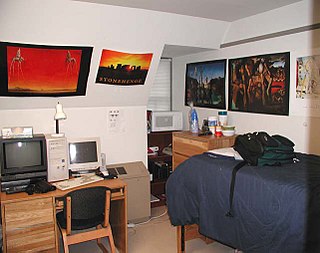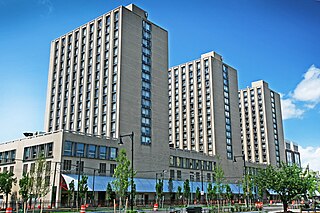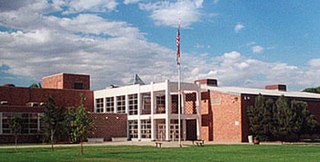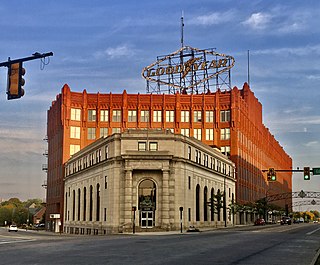
A dormitory, also known as a hall of residence or a residence hall, is a building primarily providing sleeping and residential quarters for large numbers of people such as boarding school, high school, college or university students. In some countries, it can also refer to a room containing several beds accommodating people.

Massachusetts College of Art and Design, branded as MassArt, is a public college of visual and applied art in Boston, Massachusetts. Founded in 1873, it is one of the nation's oldest art schools, the only publicly funded independent art school in the United States, and was the first art college in the United States to grant an artistic degree. It is a member of the Colleges of the Fenway, and the ProArts Consortium.

The De La Salle Santiago Zobel School, also referred to by its acronym DLSZ or De La Salle Zobel, is a private Catholic basic education institution for boys and girls run by the Philippine District of the De La Salle Brothers in Muntinlupa, Metro Manila, Philippines. It was opened in 1978 by the De La Salle Brothers because of the increasing number of students in the grade school department of the former De La Salle College in Manila.

Retriever Activities Center is a 4,024-seat multi-purpose arena in Catonsville, Maryland. The arena opened in 1973. It was home to the UMBC Retrievers basketball and volleyball teams, which represent the University of Maryland, Baltimore County in NCAA Division I athletics, from its opening until the larger Chesapeake Employers Insurance Arena opened on campus in February 2018. It hosted the 2008 America East Conference men's basketball tournament final.

Buena Vista University is a private university in Storm Lake, Iowa. Founded in 1891 as Buena Vista College, it is affiliated with the Presbyterian Church. The university's 60-acre (240,000 m2) campus is situated on the shores of Storm Lake, a 3,200-acre (13 km2) natural lake.

The Boston University housing system is the 2nd-largest of any private university in the United States, with 76% of the undergraduate population living on campus. On-campus housing at BU is an unusually diverse melange, ranging from individual 19th-century brownstone town houses and apartment buildings acquired by the school to large-scale high-rises built in the 60s and 2000s.

Saint Francis High School is a Catholic, private college preparatory high school for young men that operates under the administration of Our Lady of the Angels Province of the Order of Friars Minor Conventual in Athol Springs, New York within the Diocese of Buffalo. The school was founded in 1927 by Fr. Justin Figas, OFM Conv. The school is accredited by the New York State Board of Regents and the Middle States Association of Colleges and Schools.

Tilton School is an independent, coeducational, college-preparatory school in Tilton, New Hampshire, serving students from 9th to 12th grade and postgraduate students. Founded in 1845, Tilton's student body in the 2021-22 academic year consisted of 61 day students and 129 boarding students. The typical student enrollment includes representation from 15-20 states and 10-15 countries.
Summit Pacific College is an undergraduate and postgraduate Bible college and seminary, on a foothill of Sumas Mountain in Abbotsford, British Columbia, Canada. It is accredited by the Association for Biblical Higher Education and is the theological college of the BC & Yukon District of the Pentecostal Assemblies of Canada.
St. Margaret's School is an independent, Episcopal, all-girls school located in the town of Tappahannock, Virginia, United States, on the banks of the Rappahannock River. The school is 45 miles northeast of the Richmond metro area, 100 miles southeast of the Washington metro area, and 75 miles northwest of the Hampton Roads metro area. St. Margaret's is governed by the Episcopal Diocese of Virginia. St. Margaret's opened in 1921 with 14 students and now has an enrollment of 98 girls. The student body includes international students from 18 different countries, and domestic boarding students from 17 states and Washington, D.C. Day students make up 20 percent of the student body.

Brighton High School (BHS) is a secondary school located on South 8th Avenue in the heart of Brighton, Colorado, United States. It is one of three main high schools in the Brighton 27J School District,

Withrow Hall is a dormitory and former gymnasium at Miami University in Oxford, Ohio. Under the name Withrow Court, the men's gymnasium was constructed in 1932 and was Miami's main athletic facility until the construction of Millett Hall in 1968. The building was repurposed as a dormitory in 2016, opening to students in the fall of 2018 under the new name of Withrow Hall. The building also housed the University Archives until its merger with the main library in 2016.

The Sellwood Branch YMCA, also known as the Sellwood Community Center, in southeast Portland in the U.S. state of Oregon, is a 2.5-story structure listed on the National Register of Historic Places. Built in 1910, it was added to the register in 2006.

The Birks Building is a four-storey building located on the corner of Portage Avenue and Smith Street in Winnipeg, Manitoba.

The Hopewell High School Complex, also known as James E. Mallonee Middle School, is a historic former school campus located at 1201 City Point Road in Hopewell, Virginia, United States. Contributing properties in the complex include the original school building, athletic field, club house, concession stand, press box, Home Economics Cottage, gymnasium and Science and Library Building. There are two non-contributing structures on the property.

Wills Gymnasium, often referred to as Wills Gym, was a multi-purpose athletic facility on the campus of Kent State University in Kent, Ohio, United States. Construction started in 1924 and the building was dedicated in 1925. It was the first dedicated gymnasium on the KSU campus, which had opened in 1913. Before the opening of Wills Gym, physical education classes and the intercollegiate and intramural sports teams used a variety of spaces for games and classes, both on campus in other buildings and off campus. The main gym seated approximately 4,000 people and the basement level included an indoor pool, locker rooms, and bowling alley. At the time, its capacity made it one of the largest facilities in the region. The building served as the primary home of the university's athletic teams and physical education department until 1950, when the Men's Physical Education Building opened. Wills Gym was the first permanent home of the Kent State Golden Flashes men's basketball team, and was also the original home venue for wrestling, men's swimming, men's and women's gymnastics, women's volleyball, and women's basketball.

Goodyear Hall-Ohio Savings and Trust Company is a historic building located in Akron, Ohio, US. The building is situated at 1201 E. Market Street, at the corner of Goodyear Boulevard and East Market Street. The structure is seven stories in height, built of brick and tile.

Betsy Head Park is a 10.55-acre (4.27 ha) public park in the Brownsville neighborhood of Brooklyn in New York City. The park occupies two non-contiguous plots diagonally across from each other at the intersection of Dumont Avenue and Thomas S. Boyland Street, covering a collective 10.55 acres (4.27 ha). The modern-day park contains a playground, a swimming complex, and fields for baseball, football, tennis, and basketball. The park's swimming complex, the Betsy Head Play Center, was designed by Ely Jacques Kahn and consists of a bathhouse, a general swimming pool, and an infilled diving pool. The park is operated by the New York City Department of Parks and Recreation, also known as NYC Parks.

The National Council of Young Men's Christian Associations of the United States of America is part of the worldwide youth organization YMCA. It has 2,700 separate organizations with 10,000 branches working with 21 million men, women and children, to "strengthen communities through youth development, healthy living and social responsibility." It employs 19,000 staff and is supported by 600,000 volunteers, and YMCA branches have about 10,000 service locations. The first YMCA in the United States opened on December 29, 1851, in Boston, Massachusetts. It was founded in 1851 by Captain Thomas Valentine Sullivan (1800–59), an American seaman and missionary.























